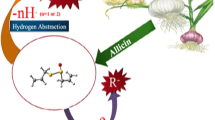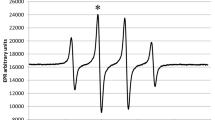Abstract
Chaparral is considered to act as an antioxidant. However, the inhibitory effects of chaparral on specific radical species are not well understood. Using electron paramagnetic resonance (EPR) spectroscopy in combination with spin trapping techniques, we have found that chaparral scavenges superoxide anion radical (O2·-) in a dose-dependent manner. 5,5-dimethyl-lpyrroline-N-oxide (DMPO) was used as a spin trapping agent and the reaction of xanthine and xanthine oxidase as a source of O2·-. The kinetic parameters, IC50 and Vmax, for chaparral scavenging of O2·- were found to be 0.899 μg/mL and 8.4 ng/mL/sec, respectively. The rate constant for chaparral scavenging O2·- was found to be 1.22 x 106 g-1s-1. Our studies suggest that the antioxidant properties of chaparral may involve a direct scavenging effect of the primary oxygen radical, O2·-.
Similar content being viewed by others
References
Miquel J, Fleming J, Economos AC: Antioxidants, metabolic rate and aging in Drosophila. Arch Gerontol Geriatr 1: 159–165, 1982
Obermeyer WR, Musser SM, Betz JM, Casey RE, Pohland AE, Page SW: Chemical studies of phytoestrogens and related compounds in dietary supplements: Flax and chaparral. Proc Soc Exp Biol Med 208: 6–12, 1995
Fridovich I: Quantitative aspects of the production of superoxide anion radical by milk xanthine oxidase. J Biol Chem 245: 4053–4057
Hodgson EK, Fridovich I: The accumulation of superoxide radical during the aerobic action of xanthine oxidase. A requiem for H2O4. Biochim Biophys Acta 430: 182–188, 1976
Kalyanaraman B, Felix CC, Sealy RC: Photoionization of melanine precursors: an electron spin resonance investigation using the spin trap 5,5–dimethyl-1–pyrroline-1–oxide (DMPO). Photochem Photobiol 36: 5–12, 1982
Zang LY, Misra HP: Generation of reactive oxygen species during the monoamine oxidasecatalyzed oxidation of the neurotoxicant, 1–methyl-4–phenyl-1,2,3,6–tetrahydropyridine. J Biol Chem 268: 16504–16512, 1993
Zang LY, Stone K, Pryor WA: Detection of free radicals in aqueous extracts of cigarette tar by electron spin resonance. Free Rad Biol Med 19: 161–167, 1995
Buettner GR, Motten AG, Hall RD, Chignell CF: Free radical production by chlorpromazine sulfoxide, an ESR spin-trapping and flash photolysis study. Photochem Photobiol 44: 5–10, 1986
Foote CS, Ching TY: Chemistry of singlet oxygen. XXI. Kinetics of bilirubin photooxygenation. J Am Chem Soc 97: 6209–6214, 1975
Zang LY, van Kuijk FJGM, Misra BR, Misra HP: The specificity and product of quenhing singlet oxygen by 2,2,6,6–tetramethylpiperidine. Biochem Mol Biol Intl 37: 283–293, 1995
Zang LY, Misra BR, Misra HP: Generation of free radicals during photosensitization of hypocrellin A and their effects on cardiac membranes. Photochem Photobiol 56: 453–462, 1992
Klug D, Rabani J, Fridovich I: A direct demonstration of the catalytic action of superoxide dismutase through the use of pulse radiolysis. J Biol Chem 247: 4839–4842, 1972
Fong KL, Mccay PB, Poyer JL, Keele BB, Misra HP: Evidence that peroxidation of lysosomal membranes is initiated by hydroxyl free radicals produced during flavin enzyme activity. J Biol Chem 248: 7792–7797, 1973
McCay PB, Fong KL, Lai EK, King MM: (1978) in Tocopherol, Oxygen and Biomembranes C. deduve and O. Hayashi (eds). Elsevier/North-Holland Biomedical Press, Amsterdam, pp. 41–57
Singh A: Chemical and biochemical aspects of superoxide radicals and related species of activated oxygen. Can J Physiol Pharmacol 60: 1330–1345, 1982
Floyd RA: Role of oxygen free radicals in carcinogenesis and brain ischemia. FASEB J 4: 2587–2597, 1990
Halliwell B, Gutteridge JMC: The antioxidants of human extracellular fluids. Arch Biochem Biophys 280: 1–8, 1990
Park JW, Floyd RA: Lipid peroxidation products mediate the formation of 8–hydroxydeoxyguanosine in DNA. Free Rad Biol Med 12: 245–250, 1992
Author information
Authors and Affiliations
Rights and permissions
About this article
Cite this article
Zang, LY., Cosma, G., Gardner, H. et al. Scavenging of superoxide anion radical by chaparral. Mol Cell Biochem 196, 157–161 (1999). https://doi.org/10.1023/A:1006982523769
Issue Date:
DOI: https://doi.org/10.1023/A:1006982523769




